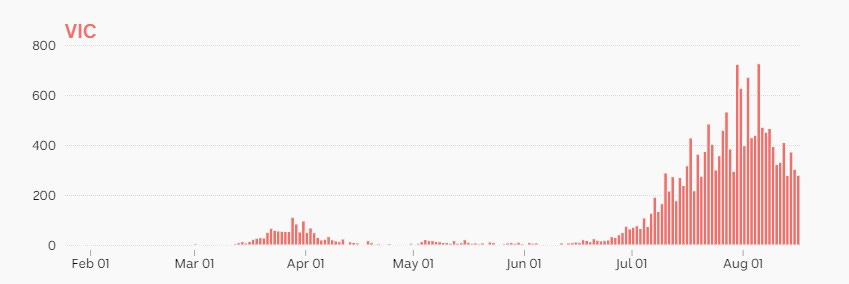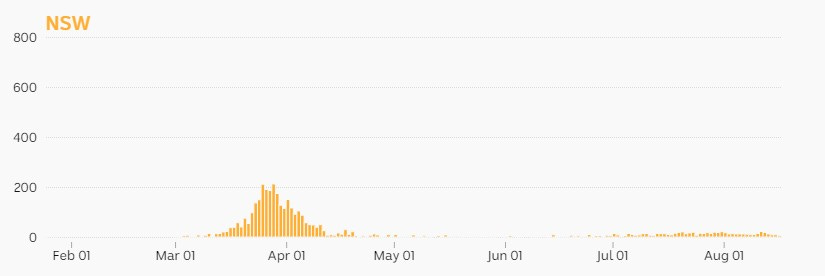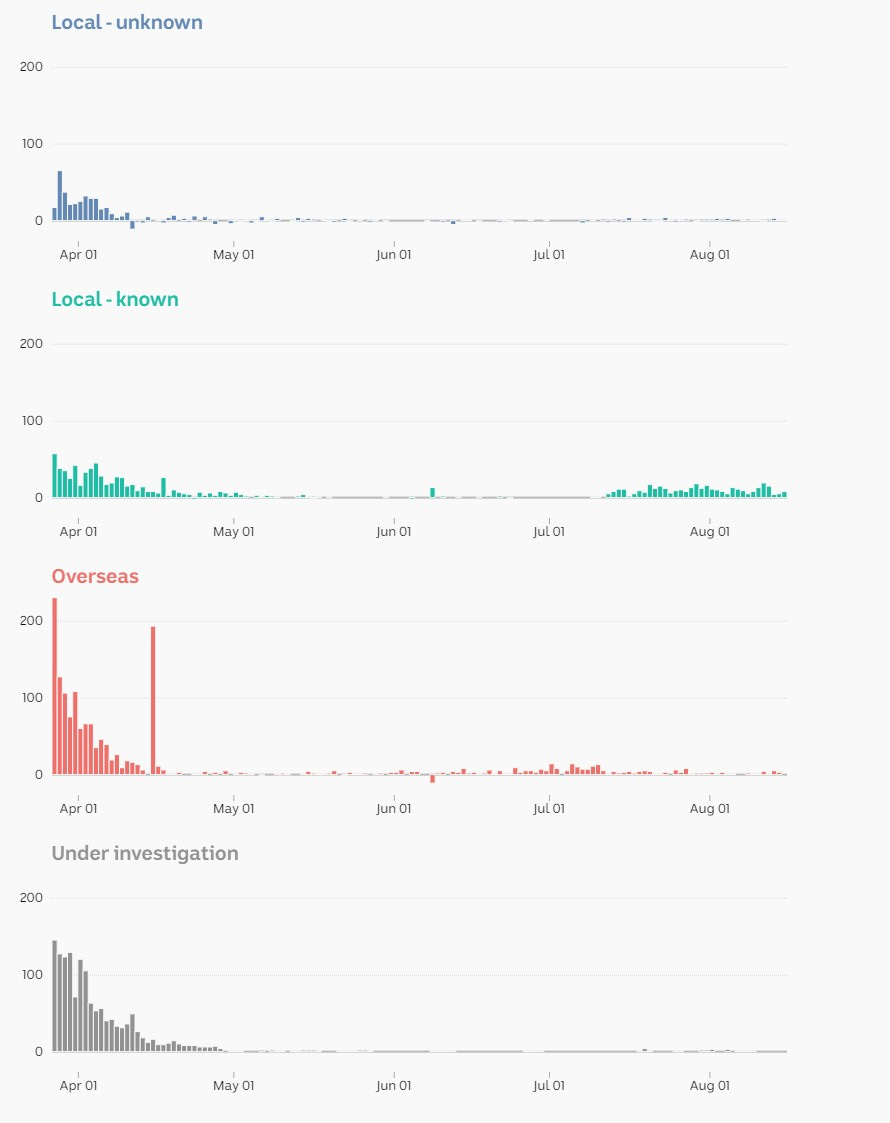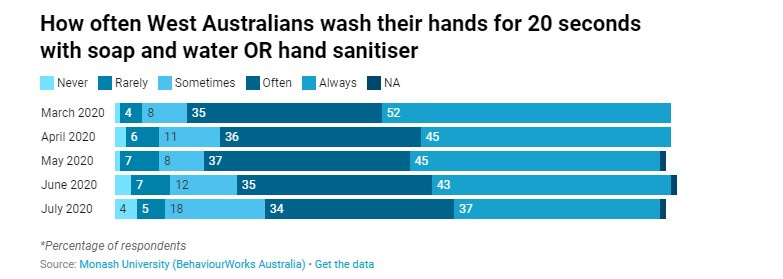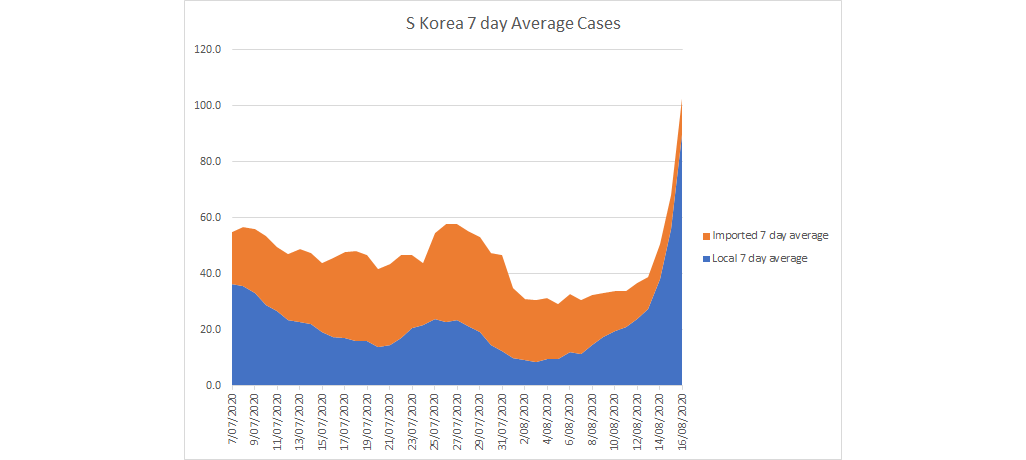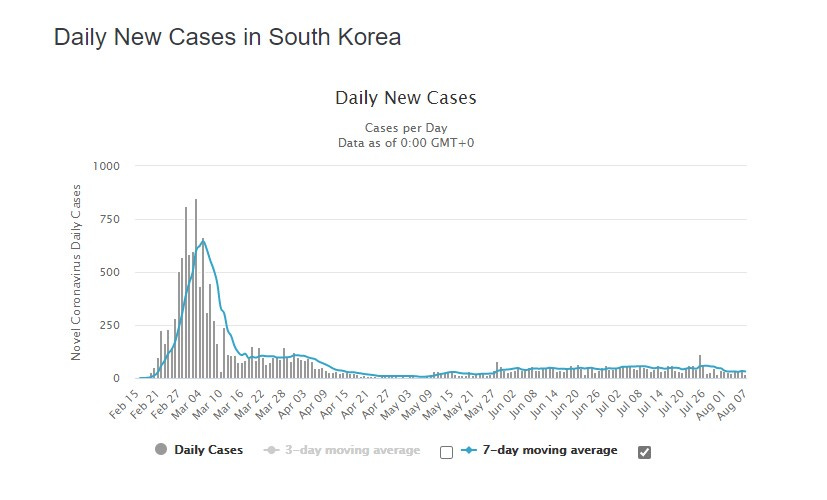Thoughts on Melbourne After the Lock Down: What might the easing of restrictions look like?
In my home city of Melbourne we have been in a pretty hard lock down for 2 weeks now. The restrictions include the closing of all non essential retail services, closure of cafes and restaurants except for contactless takeaway, and restrictions of meatworks, construction , and distribution centres. We have also had 8pm curfews except for essential workers and medical reasons, and lots of people are not allowed more than 5km from their homes. Even then we are only allowed out to shop once a day per household, exercise once a day for up to one hour, to go to work if we cannot work from home, and for medical care.
The result has been empty streets, especially in the CBD:
Source: ABC
The result has also been that we have started to see a significant reduction in the cases although we have a fair way to go:
Source: ABC
Due to this the discussions have now naturally moved to when we might start to ease restrictions and what they may look like. Pressure is coming to bear about the economic impacts and also the mental health impacts of the isolation that many people are experiencing. The Premier and the Chief Health Officer have consistently stated that they will be guided by the data and wisely are not raising expectations. I am not privy to the data they have and the strategy will be shaped by what the data says in 3-4 weeks time, not what it says now. However we have some indicators that we can use to think about what the shape of those easing strategies might look like.
New South Wales
First of all, closest to home we have the experience of NSW which has been bubbling away with cases in the teens since early July:
Source: ABC
The graph contains both locally transmitted cases and returned travelers in quarantine but the main clusters have been related to hotels and restaurants that appear to have seeded from one case at a hotel. Then there are a range of smaller clusters related to schools, and funeral services. Due to good management and a little luck most of the new cases have been linked to known clusters or in quarantine:
Source: ABC
The main lessons here seem to be maintaining a strong testing and contact tracing regime plus the high risk around hotels and restaurants.
New Zealand
A little further away we have New Zealand where after 102 days without a local transmission they now have 69 active cases with an increase of 13 in the 24 hours before writing this ( August 16th. Source: NZ Ministry of Health). The main lesson here is that no matter how long you are free a new case can pop up at any time and it can spread quite quickly. This is likely to mean that the Victorian authorities will want to get local transmission cases down to very low numbers before they are willing to open up. Especially the “mystery cases” that have no known origin.
The other lesson is that complacency can be our enemy, both in government responses to the Pandemic, and people’s attitudes to hygiene issues when the immediate threat seems to have disappeared. In Western Australia which has only had two local cases since the beginning of June we are already seeing signs of this sort of complacency (Hand washing and social distancing decline in WA, sparking warnings of complacency ):
It shows the proportion of West Australians who said they were “always” practicing physical distancing in public has fallen from 61 per cent in April to 38 per cent in early July.
Over the same period, those who said they were “always” washing their hands for 20 seconds has fallen from 45 per cent to 37 per cent
This means that when cases do pop up there is an increased risk of higher rates of transmission. It is almost impossible for people to overcome the cognitive exhaustion that comes with little or no exposure to threats so public health responses need to be designed to account for that.
South Korea
South Korea is currently experiencing a rapid acceleration in confirmed cases after a long period with a relatively low number of cases. Locally transmitted cases rose from 23 on August 11th to 267 cases on August 16th (source: South Korea CDC ). The steepness of the change can be seen even in the 7 day average figures which tend to smooth out variations (CDC data, my graph):
A longer term graph that finishes just prior to the current rise (Source: Worldometer ) shows the overall pattern:
South Korea had a reasonably high initial outbreak that they were able to control, in part because it was very tightly clustered around a religious sect. A second bump from late May onwards was related to nightclubs in Seoul. The latest cases seem to centre around a number of churches. The CDC statement of August 15th said:
Related to Woori Jaeil Church in Yong-in City, Gyeonggi Province, 33 additional cases (32 church members, 1 acquaintance) were confirmed as a result of testing 401 church members and contacts. In total, 105 cases have been confirmed.
– All the 900 church members are under self-quarantine. According to an epidemiological investigation, suspected risk factors are not wearing a mask during service by choirs, sharing a meal after the service, and continued home visits.
○ Related to the Sarang Jaeil Church in Seongbuk-gu, Seoul City, 40 additional cases were confirmed. In total, 59 cases have been confirmed.
– According to an epidemiological investigation, on 9 August, due to the heavy rain the indoor density increased and led to less than 1m distance between participants. Singing hymns in this environment is suspected to be the risk factor.
* 1 acquaintance was reclassified as a church member
** Seoul = 38, Gyeonggi = 13, Gangwon = 2, Incheon = 6
○ Related to the Yangchun Rumination Church in Seoul City, after a first case was confirmed on 12 August, 3 additional cases were confirmed (2 church members, 1 acquaintance). In total, 4 cases have been confirmed.
– According to an epidemiological investigation, congregation worshipping shoulder-to-shoulder in a small space without a mask on is suspected to be the risk factor.
○ Related to Rejoice 153 Church in Gyeonggi Province, 2 additional case was confirmed while under quarantine. In total, 26 cases have been confirmed.
○ Related to the Banseok Church in Pung-dong, Goyang City, Gyeonggi Province, 1 additional case was confirmed during contact investigation (Namdaemun market visitor) and another case was confirmed while under self-quarantine (a day care attendee). In total, 36 cases have been confirmed.
○ Related to a group event in Yangpyung-gun, Gyeonggi province, 31 out of the total 61 participants of a community event were confirmed. Further investigation is underway for contacts and route of transmission.
– According to an epidemiological investigation, no mask wearing and group meal in a small space are suspected to be risk factors.
On 16th August they said:
Related to the Sarang Jaeil Church in Seongbuk-gu, Seoul City, 190 additional cases were confirmed. In total, 249 cases have been confirmed.
and:
Related to a Starbucks in Paju City, Gyeonggi Province, 12 additional cases were confirmed as a result of contact investigation of visitors and their contacts. In total, 29 cases have been confirmed.
A number of smaller clusters have also been reported.
These results would seem to indicate that large indoor gatherings when there are low levels of virus circulating in the population are certainly a major risk as can cafes.
From this information we can speculate about the lockdown restrictions relaxing situation in Melbourne with varying degrees of certainty. The levels of certainty here are predicated in part on my view that the government will want to see levels of local transmission in the single digits outside of an defined cluster before they do too much. They will also be more cautious than they were prior to this outbreak, in part because the political backlash of relaxing restrictions too fast and another outbreak occurring might fatally wound the government.
High Certainty
- Any large scale indoor gatherings such as music events, high volume church services, conferences ,etc are off the cards for quite a while. Given that I earn part of my living from paid speaking engagements this is of particular interest to me.
- Any large scale outdoor events are off the cards for a shorter time than the indoor events but still a fair period. This means the Spring Racing Carnival, AFL Grand Final, etc are all likely doomed in Melbourne if they weren’t already, in part due to the uncertainty. Many events will now be skittish about organising to go ahead with the level of uncertainty that is present.
- Stopping restaurants and cafes opening without serious distancing measures in place is also fairly certain given that we have seen spread in New South Wales and South Korea.
- Wearing masks is here to stay for an extended period – If I had to guess, mandatory for at least six months. It may be relaxed for outdoor exercise earlier than this.
- Allowing people to visit each others houses in small numbers will be allowed fairly quickly because of the social and political pressures. It is likely that this will be family members only at the beginning to reduce levels of mixing. Increasing the numbers will be done very cautiously after the first relaxation.
- Construction , distribution centres and meatworks will be allowed to resume full capacity as soon as numbers get low enough. This will be with strict COVID Safe Plans and probably external monitors in place. These businesses are too important to the economy and food supply chains to be restricted for too long.
- The 8 pm curfew will be lifted as soon as numbers get low enough, as will the 5km travel limits because of the social pressures to do so. This is tied to allowing people to visit each other.
- Work from home if you can work from home will be a high priority for government. It may even be reinforced with employer penalties for forcing people to come to work when they do not need to. This measure reduces people interacting, reduces pressure on space in public transport, and has minimal economic impact.
- Schools will remain closed until at least October 5th because Term 3 finishes 5 days after the end of the proclaimed 6 week lock down. So it makes no sense to open up for 5 days even if the case numbers are low.
- Restrictions on exercising for one hour maximum will be removed as it is generally a low risk activity.
- International barriers to travel in both direction will remain as 14 day quarantine but the caps on inbound travelers will be relaxed as more confidence is gained in how to run the system after the Judicial inquiry into quarantine hotels is complete. We cannot completely lock our borders but at the same time if we are trying to drive local transmission numbers right down we cannot have large numbers of international visitors seeding virus into the general population. Increased numbers strains the quarantine system and no quarantine and test system is perfect so higher numbers means a higher chance of a new seeding case unrelated to existing known cases.
Medium Certainty
- Cafes and restaurants kept closed for at least 2 weeks after the first rules are relaxed to monitor behaviour and case levels from the first changes before putting people together in groups outside of their family groups. Maybe even 4 weeks.
- Then cafes and restaurants opened up with maximum caps on numbers per venue/physically separate area, and strict 4 square metre rules per person. In addition they will be required to put in place extended COVID Safe plans, plus external monitors for any venue above a certain size. Serving will require patrons to be seated. Given the experiences in implementing this in NSW there will be a lot more checking going on than in the past. Not all venues will open up in these circumstances due to the economic issues.
- Church services will be allowed to resume but only with small numbers and high levels of social distancing and similar sort of check in requirements as cafes.
- Shopping centres and major non essential retail will re-open with limits on how many people can enter a store and a shopping centre as a whole. This may include closing some entrances, and creating booking systems.
- Schools and childcare to open up for younger age groups to ease pressure on parents working and trying to home school children at the same time. Cohorts Year 9 and older may remain schooling from home for a longer period as they require less supervision. There have been numerous cases of schools closed in Victoria and NSW in the last two months for cases so there will be caution here.
There are obviously a large number of other considerations but in the interests of some brevity I will leave it there.
Addendum
The South Korea CDC stated on August 18th that:
The 13th COVID-19 Public Perception Survey found that the percentage of respondents who responded that “Domestic COVID-19 transmission situation is serious” (“Agree” / “Strongly Agree”) has decreased by 28 percentage points during the month of July. Also, only 12% responded positively to “I could get infected with COVID-19”.
It seems clear that complacency may have paid a large part in the increase in local cases in South Korea. Complacency is definitely our enemy in the future if the lock down works well.
If you want to contact us to discuss your strategy approaches please CLICK HERE
If you want to receive our twice-monthly newsletter then please subscribe at SUBSTACK


